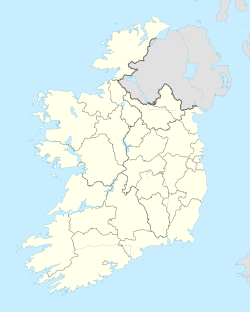
The Pale or the English Pale was the part of Ireland directly under the control of the English government in the Late Middle Ages. It had been reduced by the late 15th century to an area along the east coast stretching north from Dalkey, south of Dublin, to the garrison town of Dundalk. The inland boundary went to Naas and Leixlip around the Earldom of Kildare, towards Trim and north towards Kells. In this district, many townlands have English or Norman-French names, the latter associated with Anglo-Norman influence in England.
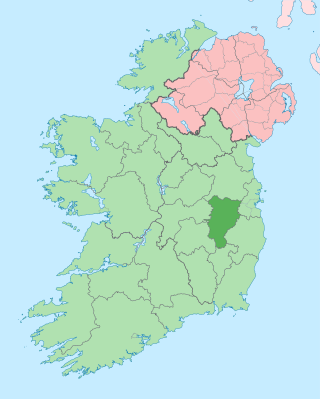
County Kildare is a county in Ireland. It is in the province of Leinster and is part of the Eastern and Midland Region. It is named after the town of Kildare. Kildare County Council is the local authority for the county, which had a population of 246,977 at the 2022 census.

Kildare is a town in County Kildare, Ireland. As of 2022, its population was 10,302, making it the 7th largest town in County Kildare. It is home to Kildare Cathedral, historically the site of an important abbey said to have been founded by Saint Brigid of Kildare in the 5th century. The Curragh lies east of the town.
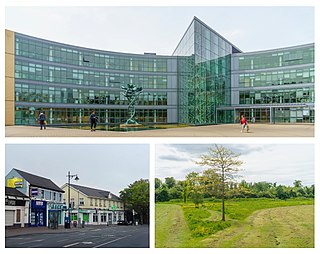
Blanchardstown is a large outer suburb of Dublin in the modern county of Fingal, Ireland. Located ten kilometres (6 mi) northwest of Dublin city centre, it has developed since the 1960s from a small village to a point where Greater Blanchardstown is the largest urban area in Fingal.
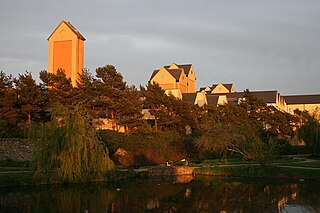
Naas is the county town of County Kildare in Ireland. In 2022, it had a population of 26,180, making it the largest town in County Kildare and the fourteenth-largest urban centre in Ireland.
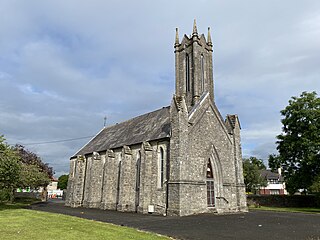
Newbridge, officially known by its Irish name Droichead Nua, is a town in County Kildare, Ireland. While the nearby Great Connell Priory was founded in the 13th century, the town itself formed from the 18th century onwards, and grew rapidly alongside a military barracks which opened in the early 19th century. Taking on the name Newbridge in the 20th century, the town expanded to support the local catchment, and also as a commuter town for Dublin. Doubling in population during the 20 years between 1991 and 2011, its population of 24,366 in 2022 makes it the second largest town in Kildare and the sixteenth-largest in Ireland.
Castleknock is an affluent suburb located 8 km (5 mi) west of the centre of Dublin city, Ireland. It is centred on the village of the same name in Fingal.

Clara is a town on the River Brosna in County Offaly, Ireland. It is the 10th largest town in the midlands of Ireland. The town had a population of 3,403 as of the 2022 census.

Sallins is a town in County Kildare, Ireland, situated 3.5 km north of the town centre of Naas, from which it is separated by the M7 motorway. Sallins is the anglicised name of Na Solláin which means "the willows".

Straffan is a village in County Kildare, Ireland, situated on the banks of the River Liffey, 25 km upstream of the Irish capital Dublin. As of the 2016 census, the village had a population of 853, a nearly two-fold increase since the 2006 census.

The Kildare County Board of the Gaelic Athletic Association (GAA), or Kildare GAA, is one of 12 county boards governed by the Leinster provincial council of the GAA in Ireland, and is responsible for the administration of Gaelic games in County Kildare.

Ballymore Eustace is a small town situated in County Kildare in Ireland, although until 1836 it lay within an exclave of County Dublin. It lies close to the border with County Wicklow. The town is in a civil parish of the same name.
County Kildare in the province of Leinster, Ireland, was first defined as a diocese in 1111, shired in 1297 and assumed its present borders in 1836. Its location in the Liffey basin on the main routes from Dublin to the south and west meant it was a valuable possession and important theatre of events throughout Irish history.

Kilcullen, formally Kilcullen Bridge, is a small town on the River Liffey in County Kildare, Ireland. Its population of 3,815 at the 2022 census made it the 13th largest settlement in County Kildare. From 2002 to 2011, it was one of the fastest growing towns in the county, doubling its population from 1,483 to 3,473. It is situated primarily in the Barony of Kilcullen, with a part in the Barony of Naas South, and subsidiary areas include Logstown, Harristown, Carnalway and Brannockstown, Gilltown, Nicholastown, and Castlemartin.

Caragh or Carragh is a village in County Kildare, Ireland. It is located on the R409 regional road between the River Liffey and the Grand Canal and is located 6.1 km north-west of Naas. The village is also 7.9 km from Clane and 10.6 km from Newbridge.

Croghan is a village in County Offaly in Ireland. It is situated near Croghan Hill, on an "island" of high ground surrounded by an expanse of raised bog which forms part of the Bog of Allen. The village is in a townland and civil parish of the same name.
Turnings is a townland in County Kildare, Ireland. It is situated on the banks of the Morell River, a tributary of the River Liffey. It is a rural area between Clane and Straffan.

Leixlip is a town in north-east County Kildare, Ireland. Its location on the confluence of the River Liffey and the Rye Water has marked it as a frontier town historically: on the border between the ancient kingdoms of Leinster and Brega, as an outpost of The Pale, and on Kildare's border with County Dublin. Leixlip was also a civil parish in the ancient barony of Salt North.
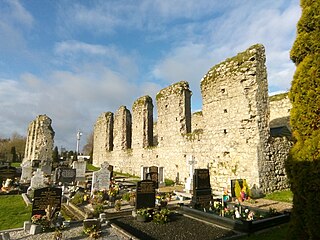
Clane Friary, also called Clane Abbey, is a former friary of the Order of Friars Minor Conventual located in Clane, Ireland.

